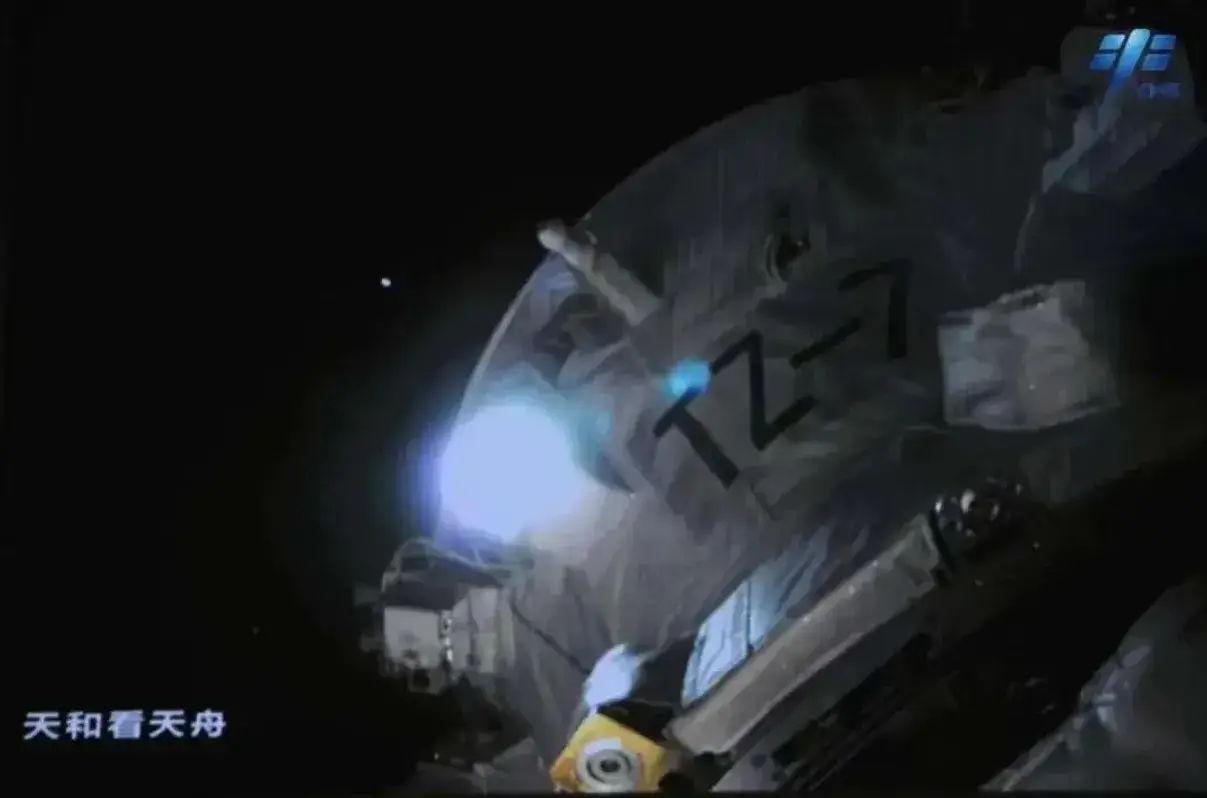The spacecraft carries food and water for the astronauts as well as scientific experiments, one of which is the study of archaea in space conditions to try to recreate the conditions on the early Earth

A view of the Tianzhou-7 cargo spacecraft from the Tianhe Central Module of the Tiangong Space Station. Credit: China Manned Space Engineering Office (CMSEO).
The Tianzhou-7 cargo spacecraft docked at China's Tiangong Space Station on Wednesday carrying supplies to the Chinese space station.
The Long March 7 rocket took off from the Wenchang Satellite Launch Center on Hainan Island on January 17 at 16:27 PM Israel time. Tianzhou-7 detached from the launcher and entered its designated orbit 10 minutes later, China's Manned Space Engineering Office (CMSEO) announced.
Tianzhou-7 docked at Tiangong three hours later. The Shenzhou-17 crew aboard the space station then entered the payload bay and began transferring objects and other related work.
China completed construction of the space station in late 2022 and is sending three-person crews on six-month missions. Each mission includes a transfer of command, during which six astronauts are briefly on board.
Tianzhou-7 contains 260 items of artifacts, with a total weight of about 5.6 tons. Of these, about 2.4 tons are supplies for astronauts, including fresh fruits and vegetables and gift packages related to the upcoming Year of the Dragon.
60 science units include an experiment focusing on human bone cells and another experiment containing anaerobic archaea, which will examine the vitality and methane production of the ancient living creatures on Earth in the space environment.
CMSEO is also promoting low-cost freight delivery alternatives to Tiangong. The agency issued a call for proposals in May 2023 and selected four proposals in September to advance to the detailed planning phase.
Although all of the bids selected for the cargo spacecraft came from government entities, it appears that the Chinese agency will also use commercial launchers and not just Long March missiles.
China plans to launch three more missions to Tiangong in 2024. These will be the manned missions Shenzhou 18 and 19 (to exchange crews on the station) and another resupply mission on the Tianzhou-8 spacecraft in the summer.
China plans to expand Tiangong by connecting a multipurpose module. This module will allow additional full size modules to dock with the space station. They will also help extend the life of the station, keeping it in orbit long after the International Space Station is expected to burn up in the atmosphere.
China plans to launch three more missions to Tiangong in 2024. These will be the manned missions Shenzhou 18 and 19 (to exchange crews on the station) and another resupply mission on the Tianzhou-8 spacecraft in the summer.
The Chinese space program continues to gain momentum
The Chinese space station Tiangong (Chinese: 天宮, "heavenly palace") is a Chinese space station located in low Earth orbit between 340 and 450 km above the surface. This is China's first long-term space station and is part of the "third phase" of China's manned space program. Tiengong is built on the basis of the experience gained from the previous space stations, Tiengong-1 and Tiengong-2, and contains more advanced technologies. Its first module, Tianhe ("Harmony of the Sky"), was launched on April 29, 2021, and two more modules were added to it by 2022. The station is operated with a mass between 80-100 tons, about a fifth of the mass of the International Space Station and about the size of the Russian space station Mir
The Chinese space program, created in 1992, included many projects such as the launch of five unmanned and four manned spacecraft as part of the Shenzhou program. The first manned launch was carried out aboard the Shenzhou 5 spacecraft on October 15, 2003, with the first Chinese technaut, Yang Liwei. The Shengzhou program continued with additional missions, including the manned launches of Shengzhou 6 and Shengzhou 7.
The China National Space Administration (CNSA), is the national space agency of the People's Republic of China, responsible for the Chinese space program. The agency was established on April 22, 1993 and is located in Beijing. It was created following the disintegration of the Ministry of Aeronautics Industry of China into two groups: CNSA and the China Space Technology Corporation (CASC).
CMSEO, also known as China Manned Space Engineering Office, is China's manned space agency. It is responsible for the planning, development and execution of China's manned space missions. CMSEO operates under the China National Space Administration (CNSA) and is operated by the Ministry of Industry and Information Technology of China.
More of the topic in Hayadan:
- China plans to send three astronauts to its space lab this summer
- The Chinese manned spacecraft Shenzhou 9 was successfully launched
- China may gain a monopoly on space stations
- After a three-year absence, China will return to space this year with a new station
- The Shenzhou 9 spacecraft and its three crew members returned safely to Earth
